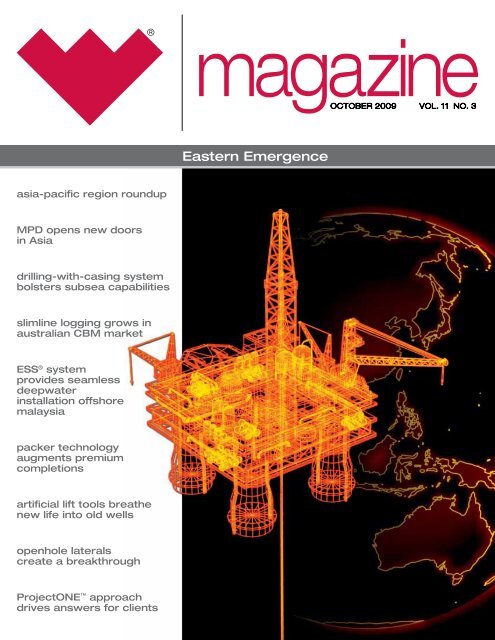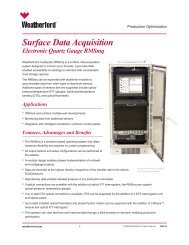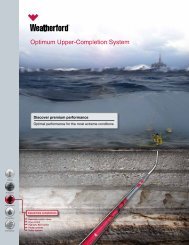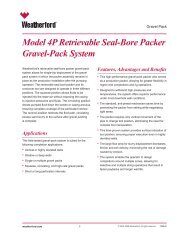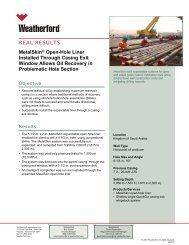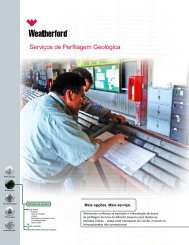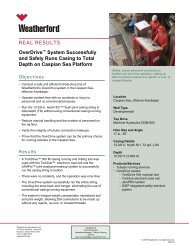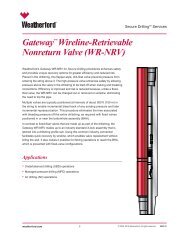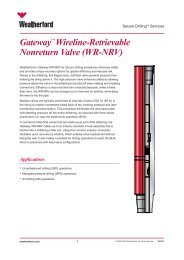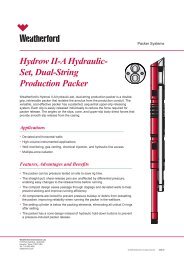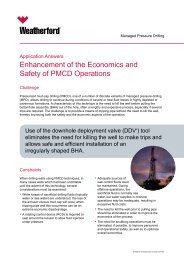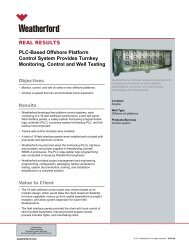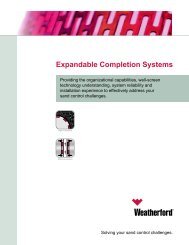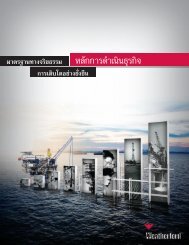Magazine - Weatherford International
Magazine - Weatherford International
Magazine - Weatherford International
- No tags were found...
Create successful ePaper yourself
Turn your PDF publications into a flip-book with our unique Google optimized e-Paper software.
Buildmore accurate control.The Secure Drilling systemmakes previously undrillablewells drillable:• Enabled HPHT explorationwell to reach TD for the firsttime after 8 failed wells(Mediterranean Sea).• Enabled drilling to depthsnever reached previouslywhen drilling conventionally(offshore Libya).More precise wellbore pressure management. That’s the ultimatebenefit you get from the Secure Drilling system. Improved accuracy ofmeasurement and analysis for flow and pressure data allows drillingdecisions to be made based on actual real-time data.The system also features a simple yet flexible design, making it adaptableto virtually any well – even ones previously thought to be undrillable.Better control means reduced risk and decreased downtime, combinedwith increased safety and significant flexibility.It’s not just managed pressure drilling—it’s secure drilling.To learn more about how you can build more accurate control with theSecure Drilling system, view our webcast at weatherford.com/mpd.© 2009 <strong>Weatherford</strong> <strong>International</strong> Ltd. All rights reserved. Incorporates proprietary and patented <strong>Weatherford</strong> technology.
magazinecontentsforewordTechnology, Partnerships Gain Traction in Asia 2in focusAsia Pacific 3drillingNew Drilling-with-Casing System Brings Subsea Capabilities 8MPD Opens New Doors in Asia 11evaluationSlimline Logging Grows in Australian CBM Market 14completionDeepwater Completion Installation, a Seamless Team Effort 17Bringing Advanced Packer Technology to Premium Completions 19productionArtificial Lift Tools Breathe New Life into Old Wells 21interventionBreakthrough in Openhole Laterals 24EEPStandardization Drives Project Management Excellence 26A publication of <strong>Weatherford</strong> <strong>International</strong> Ltd.Vol. 11, No. 3<strong>Weatherford</strong>’s W <strong>Magazine</strong> is published by <strong>Weatherford</strong> <strong>International</strong> Ltd. Please direct all correspondence regarding thispublication, including reprint requests, to Tina Graham, 713.297.2588, or tina.graham@weatherford.com.Editor-in-ChiefChristine McGee, Vice President, Marketing ServicesManaging EditorChristine Mathers, Manager, Corporate CommunicationsBusiness EditorsGary Aaron, Marketing ManagerJudy Feder, Marketing ManagerAngie Gunden, Marketing ManagerDinah Kumbera, Marketing SpecialistGraham Makin, Director, Technical MarketingShannon Myers, Marketing ManagerSherri Scott, Marketing ManagerPat Wright, Manager, Content DevelopmentContributorsGreg Anderson, Ron Barker, Scott Beattie, Andre Broussard,Dave Brunnert, T Scott Campbell, David Collecott, David Colley,Brian Davis, Linda Day, Guy Feasey, Shane Fleck, Alistair Geddes,Martin Geddes, Brian Grayson, Annabel Green, Blake Harvey,William Hearn, WuenFung Hor, Carel Hoyer, Mark Johnson, Rich Jones,Joe Jordan, Jason Kent, David Labonte, Bill Law, Shanta Mauney,Steve McBride, Kevin McWilliam, Ted Moon, Keith Morley,Alan Morrison, Steve Nas, Dean Norcross, Horst Peak, Mary Powledge,Nina Rach, John Raine, Alvaro Ramirez, Scott Robinson, Brian Scott,Richard Shook, Mike Slaton, Tiffany Smith, Garry Templeton, JulmarShawn S. Toralde, Yong Wang.Layout and DesignEleanor Shanks, Senior Graphic DesignerProductionAnthony Drago, Print Production Manageroctober 2009 1
Technology, Partnerships Gain Traction in AsiaAlistair Geddes, Vice President, Asia Pacific regionIt will come as no surprise that<strong>Weatherford</strong> provides a vast array ofproducts and services to the Far East.What may be surprising, however, isthe depth of technology and level ofpartnership cultivation that is going ontoday to service the Asia Pacific market.The Asia Pacific region is home to everything from theextreme winter colds of Northern China to the equatorialclimates of South East Asia. The operating landscapeincludes everything from mature low rate onshore andoffshore fields, to emerging deepwater plays.The region is also home to world-class gas fieldsundergoing development planning and an everincreasingimportance of unconventional assets, suchas coalbed methane (CBM) and geothermal. Ourability to understand our clients’ unique challenges inthese environments and to build and adapt technologyand services for special applications is critical to ourcombined success in these environments.As with all other regions of the world, safety, cost, valueand fit-for-purpose technology remain key drivers,harnessed of course via quality service delivery. Withdeepwater activity on the rise in Asia Pacific, the regionbrings not only NOCs, but an increasing focus fromIOCs as well. Our ability to deploy global-scale and oftengame-changing technologies will continue to drive ourefforts in the region.Importantly, it’s not just about having the righttoolkit, but the right people and application expertisebehind those tools to support our clients’ increasingtechnology challenges. Alignment with our clients iskey to developing technologies that address specificrequirements in often unconventional scenarios. We’vespent a great deal of time listening to our clients andbuilding true partnership alliances with them, which youwill read more about in this issue.This issue of W <strong>Magazine</strong> discusses some of our keytechnologies and applications designed to meet specificclient needs. Several of these articles demonstrateour ability to deploy technologies, many in the AsiaPacific region, to achieve the ultimate goal—optimalperformance for our clients through close alignment withtheir business objectives. Here are just a few highlightsfrom this issue:In Focus: Asia Pacific explores <strong>Weatherford</strong>’s activepush in recent years to increase infrastructure,streamline supply chains and focus on excellence inservice delivery. This article uncovers how the companyis yielding some innovative technology solutions forclients of all sizes—from individual services to bundledsolutions, including several world-class projects.MPD Opens New Doors in Asia highlights how thecompany’s rapidly advancing technology and capabilityto drill the undrillable, while reducing costs andimproving safety, are making MPD a key facilitator in theworld’s toughest plays.Slimline Logging Grows in Australian CBM Marketshares how <strong>Weatherford</strong>’s expanding suite of formationevaluation capabilities, laboratory-based analysis and ateam of CBM specialists is helping clients evaluate andexploit CBM plays in Australia and beyond.Deepwater Completion Installation—a Seamless TeamEffort demonstrates how careful planning and executionenabled a team of <strong>Weatherford</strong> and Asia Pacific clientengineers to install ESS ® expandable sand screen in asingle trip for a Malaysian deepwater field development.These articles, and the remainder of the magazine,emphasize just a few of the ways <strong>Weatherford</strong> isworking hand-in-hand with operators in Asia Pacific andaround the world to plan, implement and deploy theright technologies, in the right environments for strongerproduction results.2 magazine
In Focus: Asia Pacific<strong>Weatherford</strong> ramps up activities and technology deployment inAsia Pacific—from Bohai to Taranaki—while ensuring safety is the critical priority.<strong>Weatherford</strong> has a lengthy history in many of the countriescomprising the Asia Pacific region. In addition, an activepush during the past three years to increase infrastructure,streamline supply chains and focus on safety andexcellence in service delivery is yielding some innovativetechnology solutions for clients of all sizes. Undertakingsrange from individual services to bundled solutions,including several world-class projects.Project Management: CITICIn September 2008, after a rigorous competitive biddingprocess, <strong>Weatherford</strong> won a turnkey contract to drill andcomplete 165 wells on four man-made islands in theYuedong oil field (Liaodong Bay) for Tincy Group EnergyResources Ltd., a subsidiary of CITIC Energy Resources Ltd.Tincy Group holds the rights to develop and operate oilfields in the Hainan-Yuedong Block in the Bohai Bay Basinin China’s northeastern Liaoning province until 2034. Theblock covers more than 116 square miles (300 squarekilometers). CITIC representatives say that oil is found inan area of 47 square miles (122 square kilometers). Theprincipal Yuedong oil field holds an estimated 63.5 millionbarrels of recoverable oil reserves.Under an operations agreement, Tincy cooperates withChina National Petroleum Co. (CNPC), the operator ofthe adjacent Nanbao field, in developing the Hainan-Yuedong block.“By winning this contract, <strong>Weatherford</strong> becomes the firstinternational energy service company to deliver integrateddrilling and completion services of this scale in theChina market,” says Alistair Geddes, <strong>Weatherford</strong>’s VicePresident, Asia Pacific.<strong>Weatherford</strong> is also the first international energy servicecompany to be issued an Oil Operation Safety Certificatefrom China’s National Safety Bureau.<strong>Weatherford</strong> is providing a wide scope of services in theYuedong field, including project management, engineeringdesign, drilling operations, directional surveys, cementing,fishing, casing and tubular running, mud logging, wirelinelogging, perforating, pump installation, wellhead andChristmas tree installation, production pump and surfacecontrol, completion, and well testing.“By winning the [CITIC]contract, <strong>Weatherford</strong>becomes the firstinternational energyservice company todeliver integrateddrilling and completionservices of this scalein the China market.”The project includesintegrated mud-loggingunits, which are beingbuilt in Singapore. “Theunits are based on existingstandard designs thathave been customizedto accommodate drillingservices and surfaceloggingservices,”says Alan Morrison,<strong>Weatherford</strong>’s RegionalBusiness Unit Manager forSurface Logging Systems.“The units were modifiedto help our client saveCAPEX on the multiservice CITIC project and resulted incost savings of about US$120,000 per rig.”The project will ultimately use five rigs. The modificationsalso saved topside space by removing the need for aseparate drilling services unit thus enabling the runningof combined drilling and surface-logging systems from asingle rigsite cabin.The first modified unit is already in operation in China.“To our knowledge, this unit is the first such combinedservice cabin operating globally,” says Morrison. “Thisinnovation has spawned a dedicated review of cabindesigns to formulate the optimum combined servicedesign and brings value to our clients by reducing costsand combining complementary services into a single workarea. Data flow, verification and analysis will be enhancedas a result.”“We believe that these combined units will provide manyapplications. Localizing our supply chain has been aneffective strategy,” says Geddes.october 2009 3
Growing Infrastructure<strong>Weatherford</strong>’s business is conducted from multiple strategic sitesin each of the Asia Pacific countries. This network is structuredto provide all the company’s myriad needs and continues tostrengthen and expand across the region.AustraliaOffices in Perth, Darwin, Adelaide, Brisbane, Sydney, Paget-Mackay, Bayswater, Bentley and Sale; operation bases in Malaga,Brisbane, Roma, Moranbah, Cardiff, Chinchilla, Emerald andAdelaide. Laboratories in Perth and Brisbane. Manufacturingat Auslog (wireline, see page 14 of this issue) and at Geebung(Johnson Screens).BruneiOffice in Brunei. Joint venture company offering industry-leadingtubular running services and rig mechanization systems.ChinaHead office in Beijing; operation bases in Tanggu and Shekou (two,first was opened in 1985). Manufacturing in Shifang (rod pumps),Shengli JV (rod pumps and progressing cavity pumps [PCP]) andTianjin (cementing).IndonesiaHead office in Jakarta; operation bases in Jakarta, Balikpapan,Duri and Batam.MalaysiaFive locations, including the region headquarters office in KualaLumpur and operation bases/offices in Kemaman, Labuan andMiri. Joint venture with QBOT. <strong>Weatherford</strong> Malaysia Sdn. Bhd.was established in Kemaman in 1978.New ZealandOffices and bases in New Plymouth. <strong>Weatherford</strong>’s machine shopin New Plymouth was voted ‘Best Repair Shop’ globally by VAMServices for 2008, besting a field of 150 competitors for the VAMlicensees’ award.PhilippinesOffice in Manila supporting <strong>Weatherford</strong>’s complete product andservice offering.SingaporeRegion support office and region logistics/support base; Pipeline &Specialty Services region office and facility. Manufacturing facilities forsurface logging systems, well screens and well control panels.ThailandSupport bases in Phitsanulok, Songkhla and Sattahip (the latterto be completed by year-end 2009). Laboratories in Ayutthaya.Administration, sales and project management office in Bangkok.VietnamOffices in Vung Tau and Ho Chi Minh; operation base in Vung Tau;manufacturing in Binh Duong (cased hole).4 magazinePhoto courtesy of Iain Farley
Frontline Management TrainingAsia Pacific has been proactive in developing itsFrontline Management Training Initiative to provideincreasingly stronger support for our clients. TheLearning and Development group in Australiaspearheaded a management development programthat integrated management development and<strong>Weatherford</strong>’s Enterprise Excellence Process (EEP).The course modules were selected to matchbusiness requirements that were customized tothe organization. The modules include personalwork priorities, operational plans, EEP skills,continuous improvement, project management,effective workplace relationships, leadership,people management, team effectiveness, safetyleadership, and innovation and change.The modular training program was deliveredin partnership with the Australian Institute ofManagement (AIM) to four groups of <strong>Weatherford</strong>’sfrontline managers in Brisbane and Perth. The firstgroup of 10 managers completed the modulesin 11 months (January through November 2008),and all 10 received a Certificate IV in FrontlineManagement in January 2009.Return on investment to the business wasimpressive. Training participants were asked todeliver back to the business a specific dollarvalue in either efficiency savings or increasedrevenue. These objectives were met and insome cases exceeded. In one case, the teamachieved a significant reduction in the priceof nonconformance with savings on service,maintenance and operation of contingencyequipment of more than US$560,000. Anothercase delivered back another US$125,600 tothe company.6 magazine
<strong>Weatherford</strong> is providing: field hardware (RPC, VFD, radiocommunication and civil work); information-technologyinfrastructure (host computer/server, CITRIX and RSA,high-speed Internet, and client’s computers with accesspoint); and the operation team.The operation team supplies two types of services:• Manual well service monitors thousands of wells permonth with dynos, ampere meters, and portable,variable-speed drives (VSDs). A technician visits thewells, rigs probes, collects data, transfers to computerserver, and manually edits and reports.• The dyno online service monitors wells using rodpumpcontrollers (RPC) with digital trunking radiocommunication and selected wells using online VSDs.This service eliminates the need to manually collectdyno cards, which can enhance safety.Tubular Running Services:Extending EfficiencyIn addition to bundled and project management solutions,the company also has been rounding out the portfoliosand capabilities of specific product lines.Until 2005, <strong>Weatherford</strong>’s tubular running services (TRS)in Asia Pacific included mainly conventional TRS withlimited mechanization. Since 2005, there has been alarge push for automated services in Australia, primarilyusing the Stabberless ® remote-controlled system, whichremoved manual casing-stabbing operations. Replacingconventional systems with mechanized systemscentered on safety and provided efficiency gains foroperators.“TRS was one of the foundation businesses for us inthe Asia Pacific region,” says Geddes. “The company’sdual strategic model of acquisitional and organic growthhave helped us extend our offerings throughout theregion. TRS is a good example of how we built a strongtechnology platform that addresses our clients’ primaryneeds—safety and efficiency.”During a four-year period in Australia, the use ofStabberless systems increased from one trial system to18 systems; and manual casing stabbing was completelyremoved from offshore operations.In 2007, in addition to the Stabberless system,<strong>Weatherford</strong> introduced other mechanization systemsto Asia Pacific, including automated tong-positioningsystems, mechanized tongs, offline stand-buildingsystems, horizontal make-break units, Iron Derrickman ®pipe-handling system and cam units.In 2008, <strong>Weatherford</strong>’s Asia Pacific region set anothermilestone by securing two long-term Indonesian tubularrunning contracts. These wins represent the company’sfirst OverDrive casing running and drilling systems to bedeployed in the region.In 2009, a new product grouping was introduced toprovide more comprehensive casing installation service,leading to the world’s first offshore drilling-with-casing jobon Diamond Offshore’s Ocean Shield jack up, off Australiafor ENI, using a 551-ton (500-tonne) modular system.Increased Technology PartnershipsTechnology continues to be critical in this region, whetherthe challenge is boosting well productivity and maximizingreservoir recovery from more mature reservoirs oroptimizing well costs via improved drilling efficiencies,well architectures and production uptimes for newdevelopment projects.“Increasingly, we are hosting joint technology sessionsin this region to develop our comprehension of ourclients’ challenges,” says Geddes. “We then can developand execute specific and appropriate technologies orpackages of technologies to address these particularissues. Our primary objective from these engagements isto form a true business partnership with the client.”For example, <strong>Weatherford</strong> held a joint technologyengagement session with Woodside Petroleum Ltd.to develop a more cohesive approach to addressingWoodside’s drilling“Our surface loggingunits were modifiedto help our clientsave CAPEX on themultiservice CITICproject and resulted incost savings of aboutUS$120,000 per rig.”and completionchallenges. The clientpresented <strong>Weatherford</strong>with comprehensiveviews of their businesschallenges and strategygoing forward. Someof <strong>Weatherford</strong>’s newertechnologies that werepresented includeddrilling hazard mitigation,formation evaluation,optical monitoring,and the developmentof expandable reservoir completion. This engagementsession was built around safety, business process andcore behaviors to showcase <strong>Weatherford</strong>’s culture aswell as its technologies with the client. The result wasa joint technology steering committee between the twocompanies that will follow working protocols for ongoingcollaboration and technology-related interaction.“Our ultimate goal with these engagements is to providea spectrum of offerings that will help our clients extractoptimum value from every reservoir, every well, every fieldand every asset,” says Geddes. “We can only providethat depth of service through closer collaboration andpartnership with our key clients.”october 2009 7
New Drilling-with-Casing SystemBrings Subsea CapabilitiesThe new SeaLance drilling-with-casing (DwC ) system extends mitigation of shallow hazards to deepwater.The challenge of subsea drilling with casing is about tobe met.In a technology agreement with the international oilcompany ENI, <strong>Weatherford</strong> plans to deploy the industry’sfirst subsea system early next year. Known as theSeaLance subsea DwC system, it enables a 20-inchcasing string and its highpressurewellhead housing to“The SeaLancesystem can benefitsubsalt and otherdifficult playsaround the world,including in theGulf of Mexico,Brazil, Africa, theSouth China Seaand Australia.”be drilled to depth, cementedand released in one run.A significant technicalachievement, the system willhave a major affect on thecosts and the capabilitiesof any deepwater drillingoperations. Most importantly,the system provides aunique capacity in mitigatingshallow hazards that canpresent a safety hazard,can constrain hole size andcontribute to making somedeepwater wells undrillable.When the prototype is run in a Houston test well in thesecond half of 2009, it will mark a major milestone in an18-month development effort. That process with ENI hasengaged a diverse set of <strong>Weatherford</strong> technologies andexperience to put all the pieces together.Moving the Concept ForwardWhen <strong>Weatherford</strong> presented the concept to ENI in2007, the system was little more than an idea.“They wanted to know if we could drill with casing in asubsea application,” says Scott Beattie, <strong>Weatherford</strong>’sGlobal Product Line Manager for Drilling with Casing.“We had some patents and ideas on paper that weshared with them, which spurred us on to continueahead to the development stage.”The subsea solution offered by the DwC system wasintriguing. Reaching total depth (TD) with the designedhole size is a challenge in deepwater applications.Unforeseen hazard zones that use up valuable casingpoints can quickly confound multistring telescopingcasing designs.Top driveLP wellheadHigh-pressurewellhead5 7/8-in.drillstring20-in. retractableshoe jointRunning toolSetting sleeve5 7/8-in.drillstring/inner stringCentralizedinner stringinside 20-in.casingCirculation subDefyer drillable casing bitThe 20-in. SeaLance system enables casing and its high-pressure wellhead housing to be drilled to depth, cemented and released in one run.8 magazine
Guy Feasey is an expat’s expatriate. His motheris English, his father a New Zealander, and hewas born in Quito, Ecuador. The family traveledextensively in South America, and when Feaseystarted at a boarding school in the United Kingdom,it was time to adjust to yet another new culture.On another continent, Feasey got his start in theoil patch in Bakersfield, California, USA, wherehe worked as a rig and diesel technician. This jobinspired him to get a degree, and so he entered NewZealand’s Otago University, which led to a job inKalgoorlie, Australia—in the gold mining business.Safe to say, Feasey has been around. And thatbackground perhaps explains how a geologist andformer gold miner found considerable successchampioning such projects as the SeaLance systemas <strong>Weatherford</strong>’s Global Strategic Business Managerfor Drilling with Casing. All those years adjustingand adapting to different cultures and perspectivesresulted in a uniquely suited individual for managingbig projects with lots of viewpoints.“You have to adapt and be diplomatic—traits manyexpats share,” observes Feasey.Colleague Scott Beattie, Global Business Unit Leader,Drilling with Casing, says, “Guy possesses a numberof <strong>Weatherford</strong>’s five core behaviors; however, humilityand intensity are at the top of the list.”Feasey says, “I love getting these projects off theground. Each one is different. You have to hit theground running and get on with it.”A case in point is the ongoing SeaLance project. Itwas envisioned in a conversation Feasey had yearsago in Sarawak, Malaysia. The concept was recentlyreinvigorated with new interest offshore Norway.Since then, deepwater drillers around the globe haveexpressed growing interest in the new SeaLancesystem. With phase one ready to roll out next year,phase two is already a hot topic of discussion.“There is much interest in the system and its variousapplications; and there are many new ideas forphase two,” says Feasey. “Now that clients havewind of it, we are getting lots of people askingquestions about it.“I’m right where I like to be—in the middle of it all.”Rethinking Casing DesignThe technology promises to be a multifaceted enablerfor drilling deepwater prospects.By managing gas and water flows, fluid losses, caverns,ledges, collapsed hole and rubble zones—to namea few—the system conserves casing points, helpingdeepwater wells reach TD with the optimal hole size.“This feature creates the opportunity to rethinkcasing designs so that hole diameter is conservedand contingency casing strings are saved for deeperproblems closer to the reservoir,” advises Beattie. “Italso leverages the capabilities of other hazard mitigationtechnologies deeper in the hole.”Lessening the need to fight shallow-hole problemsreduces NPT, lost-circulation materials, fluid systemsand other expenses. And the drilling-with-casingprocess generally achieves significant time and costssavings with combined drilling and casing operations.“Other benefits are being revealed,” notes Beattie.“Apparently vortex-induced vibrations—which can be aproblem when running large casing strings to depth—cease when the casing is rotated during drilling.”In Step with ClientsEarly development prospects for the SeaLance systemwere supported by more than 800 jobs and 10 yearsof <strong>Weatherford</strong> DwC deployments in land, platform andother surface applications. But subsea operations placesignificantly different demands on the technology.“We had the procedure,” says Beattie. “We knewgenerally what a subsea system had to accomplish. Andwe could draw from existing <strong>Weatherford</strong> technology tosuggest how that system might be developed. But weknew it was going to take a lot of engineering resourcesto produce the real thing.”The process began with brainstorming by the <strong>Weatherford</strong>team and consultation with ENI to pull the concept together.Continued collaboration and a significant investment inresearch and development greatly matured the design andbrought it to the point of creating a prototype.“ENI has been very open through the process,”observes Beattie. “Their knowledge and assistance hasmade this design process much easier.”october 2009 9
Three Key ComponentsThere are three basic components to the SeaLancesystem. In addition to the RSJ, there is the casing drill bitand the drive mechanism.The drillable casing bit is a proven technology frequentlyapplied in land and shelf-type wells where a surfaceblowout preventer (BOP) is used. But building a drivemechanism for the subsea system involved creation of arunning tool.The result is the first drilling-with-casing system that canbe deployed below the rotary table. The tool locks intoa setting sleeve below the wellhead, providing a meansthrough which casing tension is held and providing atorque path from the drillpipe through the casing to thebit. This process enables the entire string to be rotatedto make hole.The RSJ has two functions. In addition to telescopinginto itself to set the wellhead housing, it also enablesactivation of a circulating valve to enable cementingabove the drillable casing bit, which could have restrictedcirculation at the bottom of the hole. Both features will bedriven hydraulically and activated by a ball drop.Developing this system entailed a considerable designeffort that built on years of experience in multiple<strong>Weatherford</strong> product lines.“We started putting the pieces together and redesigningthis and that—before long we ended up with acompletely new system. However it is all based onexisting technology and ultimately that is the mostimportant factor,” says Beattie.Next Generation Plans“This is just the start,” says Beattie about theinitial 20‐inch system. “We are already anticipatingenhancements to improve operations and meet specificapplication requirements.”Other investigations are focused on the changes thateven larger casing diameters will require. Larger sizes—such as 22- and 28-inch systems—will require somemajor design work to handle the weight and complexityof expertly rotating such a large mass.“We have explored other sizes at rudimentary levelsand had some ‘aha’ moments that made us happy westarted with a smaller casing. But in general, things aremoving along briskly,” says Beattie.Managing Deepwater DrillingDevelopment of the SeaLance subsea DwC systemextends a proven drilling-hazard mitigation technique toa much-needed application in the upper hole.By managing shallow hazards, the system pushes casingpoints deeper in the wellbore. Contingency strings canbe applied closer to the reservoir where options areoften desperately needed, and other hazard mitigationMitigating Drilling HazardsAs the industry takes on increasinglychallenging reserves, with most ‘easy’prospects having already been drilled, theapproach must be altered. At times, newertechnologies must be deployed to minimizenonproductive time (NPT) and make thesereserves economically viable.In areas where hole instability, loss zonesor sloughing shales are a concern, DwCtechnology has been implemented to mitigatethese problems that are expected withconventional methods. Having the casingconstantly on bottom while drilling createsan environment where there is a mechanicalsmearing of cuttings against the wellbore bythe large surface of the casing, thus reducingthe previously mentioned hazards.An estimated 10 to 40 percent of expendituresare still spent drilling trouble zones. It has beenproven, however, that trouble zones can bedrilled, and sometimes avoided, if new drillingpractices are used. To be successful, drillinghazards and associated potential risks mustbe understood.Three of <strong>Weatherford</strong>’s well constructiontechnologies stand out as highly effective meansof managing and mitigating drilling hazards:• DwC drilling-with-casing systems, includingthe SeaLance system• Managed pressure drilling• MetalSkin ® solid tubular expandablestechniques can be better leveraged. As a result,deepwater wells can be drilled more efficiently and withoptimal hole size.“The SeaLance system can benefit subsalt and otherdifficult plays around the world, including in the Gulfof Mexico, Brazil, Africa, the South China Sea andAustralia,” says Beattie.The SeaLance system joins a consistently evolving<strong>Weatherford</strong> capability for mitigating deepwater drillinghazards. These technologies are changing the economicsand the drillability of many challenging assets.10 magazine
MPD Opens New Doors in AsiaRapidly advancing technology and the capability to drill the undrillable, while reducing costs andimproving safety, are making MPD a key facilitator in the world’s toughest plays—in Asia and beyond.The transition of managed pressure drilling (MPD)from reactive to proactive happened fast.From humble beginnings as an after-the-factcontingency, MPD has evolved into a suiteof hazard-prevention methodologies that arefast becoming the doorway to drilling a newgeneration of wells around the world thatpreviously were nearly impossible to drill.Nowhere is this development more apparent thanAsia, where MPD’s mitigation of total fluid lossesin the region’s notorious carbonate geology hasbeen the enabler for entire fields.Proactive success here has spurred the useof other MPD methods to solve differentdrilling problems in Asia and elsewhere. Andit has contributed greatly to the creationand refinement of a simple, but increasinglysophisticated technology.Asian RootsMPD in Asia began in 2005 for a major operatoron a production platform in Indonesia wheretotal losses and kicks were encountered in thefractured limestone. These kick-loss scenarios madedevelopment drilling on the platform near impossible.Wells were exceeding time and budgets, and this fact hada direct impact on the field development program.“Using an early pressurized mud-cap variant of MPDprovided a solution for the platform development drillingand helped to set the scene for the growth of MPD inAsia,” explains Steve Nas, <strong>Weatherford</strong>’s ControlledPressure Drilling Engineering Manager, Asia Pacific.At about the same time, Shell was fighting simultaneouskicks and losses in their limestone reef wells in east Malaysia.They brought their experience with pressurized mud-capdrilling (PMCD) in Venezuela (described in SPE 52828*) as asolution for their east Malaysia carbonate wells.Between 2005 and 2008, the <strong>International</strong> Associationof Drilling Contractors (IADC) formalized the definition ofMPD. This step along with the success of early PMCDapplications and the availability of the high-pressurerotating control devices (RCDs), opened the door to thequick adoption of MPD operations in Asia.One of the early adopters was Santos, an Australian oil andgas company. Drilling in Indonesia, Santos had experiencedsignificant kick-loss issues in the carbonates on their Jerukexploration well.The Secure Drilling system enables quick and accurate identification and controlof influxes, reducing the size of the influx and saving time compared withconventional operations.To drill the second appraisal well using the Sedco 601semisubmersible, <strong>Weatherford</strong> provided a solution using aRiserCap ® PMCD system. This project became one of thefirst successful MPD operations from a semisubmersible rig.With the successful drilling of these carbonate wells,more operators began using MPD as a best practice forreducing nonproductive time (NPT), and during the pastfour years, PMCD has become standard practice.“Today virtually all operators in Asia that are drillingthe commonly known ‘Kujung’ or ‘Baturaja’ limestoneformations call <strong>Weatherford</strong> for our MPD tools andtechniques,” says Nas. “Several field developmentscurrently ongoing in Asia would not have been possiblewithout the use of MPD techniques.”Fractured reservoirs throughout Southeast Asia are nowroutinely drilled with MPD techniques. Success in thesedifficult reservoirs is leading to more closed wellboredrilling techniques. In these applications, MPD is beingused to drill tight-gas reservoirs, high-pressure/hightemperature(HP/HT) reservoirs, and to reduce reservoirdamage and drill more effectively.The recent acquisition of the Secure Drilling systemfurther extends the application and acceptance of MPDmethods. Operators are now considering using MPD fromfloating rigs in HP/HT reservoirs.1Urselmann, R.; Cummins, J.; Worrall, R.N.; and House, G. Pressured Mud Cap Drilling: Efficient Drilling of High-Pressure Fractured Reservoirs. Paper SPE/IADC 52828 presented at the 1999 SPE/IADC Drilling Conference. 9–11 March 1999.october 2009 11
MPD’s Technology Push“We’re at the leading edge of MPD technology,”says Brian Grayson, <strong>Weatherford</strong>’s Global ProductService Line Manager for Controlled PressureDrilling. “These MPD advances provide powerfulnew solutions for drilling and succeeding in difficultreservoirs where other methods are failing.”Two recent <strong>Weatherford</strong> innovations are addingsignificantly to that capability. Next-generationmarine RCDs—the heart of MPD—are adapting thetechnology to riser and floater applications. Andadvanced algorithms in the Secure Drilling processare turning real-time data into actionable knowledgethat improves safety and drilling performance.The new marine RCD technology is the industry’sonly purpose-built device for riser and floaterapplications. It extends MPD capabilities to drillingvessels on the frontier of deepwater operations.“This marine RCD is a very novel technology,”says Grayson. “Placing the RCD as an integratedcomponent of the riser system is an industryfirst that significantly enhances performance andsafety in this unique environment.”“We ran the model 7875 RCD for the first time inNovember 2008 from a floater offshore in Libyaas a CBHP application. <strong>Weatherford</strong> deployedthe second well in March 2009,” says Grayson.“Performance is everything we expected.”The other MPD innovation is a step-change incapabilities that comes with <strong>Weatherford</strong>’s recentacquisition of its remaining interest in SecureDrilling technology.“Secure Drilling technology rounds us off asthe ultimate MPD supplier,” says Grayson. “Itsaddition takes the equation beyond traditionalMPD with precise, timely downhole pressure andflow monitoring and control.”The advanced system identifies minute downholeinfluxes and losses on a real-time basis. Usingpatented microflux technology and proprietaryalgorithms to measure and analyze flow andpressure data, the Secure Drilling process enablesdrilling decisions to be made based on actual dataversus predicted downhole environments.“This capability is a major benefit in deepwaterdrilling applications,” says Grayson. “It takesthe closed-loop MPD system and turns it into asensitive monitoring tool for quickly understandingand reacting to the downhole environment. Thenew marine RCD technology provides a significantoperational and safety advantage for dealing withdifficult pore-pressure/fracture-gradient conditionsthat are such a challenge in deepwater wells.“One of the great advantages with the Secure Drillingsystem is the capability to provide early kick detectionin HP/HT wells so that the well can be automaticallycontrolled. This benefit enables HP/HT wells to be drilledusing a closed wellbore and a fully automatic kickprotectionsystem,” says Nas.With the opening of the deepwater blocks in China, thePhilippines and Indonesia, exploration wells drilled fromdynamically positioned deepwater vessels are now beingplanned. Using MPD technology in these wells providesa significant cost and risk reduction.“Controlled Pressure Drilling ® techniques provide apotential for significant cost savings on these expensivedrilling vessels,” says Nas. “An early, automatic kickdetectionsystem enables drilling with lower mudweights, and the closed wellbore allows the pipe to bemoved while circulating—significantly reducing the risk ofstuck pipe.”Case-by-Case AdvanceNas points to several Asian case histories to illustratehow MPD is solving difficult well challenges to becomea best practice for many applications in the region.In Sumatra, Indonesia, PMCD was used to drill andcomplete a well that had been plugged and abandonedbecause of total-circulation losses and gas kicks.The objective was to drill the well to total depth andcomplete it. But that was no easy task. The well hadalready been plugged and abandoned for two yearsfollowing a 60-day effort to control total-circulationlosses and numerous gas kicks.12 magazine
Growing up with a volcano nearby, Julmar ShaunS. Toralde had an early introduction to geothermalpower. Near his home in the province of NegrosOriental in the Central Visayas region of the Philippines,two geothermal plants operated by one of the mostactive volcanoes in the country. When the region’scollege first offered a degree in geothermal engineering,Toralde enrolled.In 2005, when he joined <strong>Weatherford</strong>, it was as aControlled Pressure Drilling (CPD) Engineer in thePhilippines and Indonesia—where he was involvedwith MPD and geothermal projects. Today Toralde is<strong>Weatherford</strong>’s Engineering Coordinator for Indonesia.“Shaun is an absolute key figure here in Asia,” saysSteve Nas.” Besides being one of the hardest workingengineers we have, he is also a very polite and niceperson liked by clients and <strong>Weatherford</strong> staff alike—areal gentleman.”Toralde graduated magna cum laude from NegrosOriental State University (NORSU) with a BS ingeothermal engineering.Having been a top scholar and active student, Toraldehas always kept in mind mentorship. Shaun becamean instructor and a research coordinator in the Collegeof Engineering and Architecture of NORSU. He wasalso the Chairperson of the Department of GeothermalEngineering. Later he worked for SPI Technologieswhere he supervised copyediting and processing ofinternational technical and engineering research journals.That active pace and high achievement has continuedsince Toralde arrived in Jakarta as <strong>Weatherford</strong>’sEngineering Coordinator.“Shaun has probably made more client visits and hasbeen instrumental in promoting and winning more MPDprojects in Indonesia than anyone else,” says Nas.“He is not only a great supporter and promoter of theMPD technology but also has an incredible passion forgeothermal drilling operations.”<strong>Weatherford</strong>’s PMCD program for the well includedan RCD and drillstring float valves. When the well wasreentered and the plugs drilled out, total losses wereexperienced immediately, and gas began to migrate upthe annulus.With the RCD preinstalled, PMCD procedures were begunimmediately, and 500 feet (153 meters) of the reservoirsection was drilled. The objective was reached in 19hours without any NPT, and the completion string wassuccessfully run and cemented in PMCD mode.Kick-Loss Mitigation“Vietnam’s longest well in the Cuu Long basin’sgranite basement reservoir was drilled using constantbottomhole-pressure(CBHP) methods to avoid longstandingkick-loss problems,” says Nas.Fluid losses were common when drilling developmentwells in the fractured reservoir and resulted in frequentdrilling delays. Using CBHP methods controlledpressure at the surface so the well could be drilledwith lower-density fluid while minimizing losses.Lighter mud use increased the penetration rateenabling the well to be completed five days fasterthan planned. A significant reduction in fluid lossesminimized operational costs, NPT and postdrillingcleanup. With MPD, the loss rate was only55 barrels per hour compared to 175 barrels per hourexperienced in prior wells.Vietnam Contingency“Sometimes, the value of having MPD technologyavailable is the confidence to proceed at all,” says Nas.That was the case with the Nam Con Son limestoneformation offshore Vietnam where severe mud lossand gas migration presented an ongoing challenge.Previous wells in the region had experienced as muchas 20 days NPT because of total losses.Experience with MPD provided the confidence to tryone more time. Working from a jack-up rig, a big-boremodel 7800 RCD was installed, and PMCD techniquesreadied to provide additional control in case majormud-loss and gas-migration issues occurred.“Ultimately, losses did not require MPD operations,”says Nas. “But the operator had no way to know thatwhen they started out. Installing MPD as a low-costalternative provided the confidence to proceed.”New Drilling AheadFast-paced adoption of MPD for various applicationshas come with outstanding success in Asia and aroundthe world in mitigating some of the industry’s mostchallenging drilling hazards. With this momentum anda growing inventory of technologies, MPD is poised tomake even greater contributions to drilling capabilitiesand economics.Those in the industry who have advocated MPD haveoften said that one day we will ask ourselves why weever drilled with the annulus open to the atmosphere.Perhaps that day is now closer than we think.october 2009 13
Slimline Logging Growsin Australian CBM MarketExpansion through acquisition helps <strong>Weatherford</strong> maintain leadershipin mineral and coalbed-methane (CBM) logging activities in Asia Pacific.One can hardly ignore the sharpening global focus on unconventional gasreserves. CBM, also known as coal-seam gas, is found throughout Australia,particularly in remote areas of Queensland—far from large gas markets. But itcan be extracted and processed in regional liquefied natural gas (LNG) plants,then shipped to sales points around the globe.<strong>Weatherford</strong>’s suite of formation evaluation capabilities mesh with laboratorybasedanalysis and a global team of CBM specialists to help clients evaluateand exploit CBM plays. Using the company’s unique Compact and Slimlinesuites of wireline logging and testing tools coupled with CBM-specific, shortwheelbasetrucks enables data acquisition with light-duty logging units onvertical and horizontal wells in holes as small as 2-1/2 inches. These features arevital to the production of CBM wells.<strong>Weatherford</strong>’s Slimline logging services for CBM exploration has expandedopportunities through acquisitions. The company is committed to easternAustralia and continues to bolster its staff, equipment and activities in this regionand around the globe.Acquiring Advanced TechnologySIE, a geophysical logging tool manufacturer in Fort Worth, Texas, USA, startedoperations in Australia in the 1970s. (Eventually the company name changedto Auslog Pty Ltd.) The business initially built borehole logging systems in asmall factory in Rocklea, Brisbane, and was controlled by various companiesuntil a management buyout in 2005. Subsequently, the <strong>Weatherford</strong> group ofcompanies bought the company in March 2007. Auslog had 18 employees atthat time, but that number has increased to more than 25.“<strong>Weatherford</strong> purchased Auslog to provide the rapidly expanding Slimlinelogging group with increased manufacturing capacity, servicing and a technicalsupport center—all are necessary to meet the demands of the increasingmarket share and growing client requests for services,” said David Collecott,<strong>Weatherford</strong>’s Regional Business Development Manager for Wireline Services inAsia Pacific.Through this acquisition, <strong>Weatherford</strong> now manufactures geophysical boreholelogging equipment used in exploration and development of CBM, coal and othermineral resources. Also the company manufactures equipment for groundwaterand geotechnical investigations. The Auslog acquisition further augments<strong>Weatherford</strong>’s latest Slimline logging and innovative oilfield logging units,designed specifically for the unique requirements of CBM exploration.The Slimline logging units are the most advanced in the industry and meetor exceed all current operational and health, safety and environmental (HSE)requirements—emphasizing improved safety and efficiency.“Our CBM logging units are designed for the coalbed-methane market, whichdemands fast-operating, efficient and cost-effective units that are correctlysized for the sometimes challenging dimensions of wellsites,” said Collecott.“<strong>Weatherford</strong> is the only company offering this innovative solution to the industry.”14magazine
Core Analysis in CBM CountryWhile CBM offerssubstantial rewards, it alsopresents unique challenges.<strong>Weatherford</strong>’s phasedapproach to predict, pilotand perform CBM projectsreduces the high degreeof risk and uncertaintyassociated withCBM developments.<strong>Weatherford</strong> maintains a worldwide network of 38 coreanalysis laboratories. Two of the labs are in Australia—one inBrisbane and one in Perth.In September 2008, <strong>Weatherford</strong> acquired Australia’sACS Laboratories Pty Ltd., a regional core, fluids andCBM analytical leader. The ACS team includes geologists,chemists, engineers, core analysts, fluid-phase behaviorspecialists and field personnel with broad knowledge—providing regional expertise via eight bases across fiveAsian countries. Further, the ACS “under-one-roof” field andlab service-offerings of gas desorption, core petrophysics,formation damage, petrology and sedimentology services,reservoir fluids, and fuels analysis are unique among servicecompanies in the Eastern Hemisphere.CBM services range from sample collection and analysis toformation evaluation and reservoir engineering. <strong>Weatherford</strong>Laboratories’ experience includes more than 800 well studiesin over 30 basins with more than 150 clients during the past15 years, as well as more than 100 technical publicationsabout coalbed-methane analysis, and hundreds of industrypresentations, underscoring our “frontier and emerging gasresource expertise.”october 2009 15
Adding Capacity,Supporting Global Needs<strong>Weatherford</strong> also builds and exports minerallogging equipment to more than 70 countries,including the United States, Canada, India,China, Russia, Thailand, Indonesia, andcountries in Africa and South America.In May 2009, <strong>Weatherford</strong> opened a newmanufacturing facility in Willawong, Brisbane.This facility greatly increases the company’smanufacturing capacity, helping to meet thegrowing requirements of its clients. The newfacility builds both Slimline and conventionaltools. Also, it is now the base for assemblinglogging trucks and offers Slimline training.The site features a test well that is 984-feet(300-meters) deep and is used for new tooltesting and hands-on training.Fleet Growing, Getting Younger<strong>Weatherford</strong>’s Wireline Services groupran several new mobile logging units inQueensland—Slimline logging vehicles andCBM trucks.“We try to select the cleanest and most fuel-efficienttrucks available in a continued effort to reduce ourcarbon footprint,” said Bill Law, Operational VehicleManager for <strong>Weatherford</strong> in Australia. “Our vehiclesmust be reliable in order to support operations in areasthat are difficult to access and when working underinhospitable conditions.”The truck bodies are corrosion-resistant, constructedof aluminum and composites, and painted withpolyurethane paint for heat suppression.Designed specifically for mineral needs, <strong>Weatherford</strong>’sSlimline logging trucks carry a constant, heavy load,including 240-volt generators and pure sine-wavediesel generators. Other features include a boom arm,spooled cable, tool racks, logging tools, digital loggingsystems and software, lights, computers, medicalequipment, safety beacon, refrigerator, food, and crew.These features are intended to ensure safe, efficientoperation in the often challenging mining environment.<strong>Weatherford</strong>’s Slimline logging units are the most advanced in the industry andmeet or exceed all current operational and health, safety and environmental (HSE)requirements—emphasizing improved safety and efficiency.Australia’s state governments dictate load limits for allvehicles. Logging vehicles typically operate at 80 percentgross combination mass (GCM), compared with othercommercial trucks that operate at 50 percent GCM. Tomaintain these limits, <strong>Weatherford</strong>’s CBM units have beendeveloped specifically for the needs of the new growingindustry and are substantially smaller, more maneuverableon restricted wellsites, and highly fit-for-purpose. Theseadvantages enable exploitation of the full competitiveadvantages of the reduced size of the Compact loggingsystem. At the same time, technological capabilities tothe larger conventional oilfield units are not sacrificed. Byproviding clients with equipment and services perfectlysuited to the CBM market, <strong>Weatherford</strong> is betterpositioned to rapidly expand its fleet of logging units in thischallenging market.In early 2009, the fleet was running multiple CBM loggingjobs per month in Australia with dedicated CBM trucks.A standard suite is the “Super Stack,” which includesresistivity, neutron-density and sonic tools.16 magazine
Deepwater Completion Installation,a Seamless Team EffortCareful planning and execution enabled a team of <strong>Weatherford</strong> and Asia Pacific client engineers to install ESS ®expandable sand screen in a single trip for a Malaysian field development—the first deepwater field offshore Malaysia.Northwest of the Malaysian island of Labuan and ata water depth of 4,331 feet (1,320 meters), existsan impressive development with equally impressivedevelopment challenges. The field—the first deepwaterdiscovery in Malaysia—has a highly laminated reservoirstructure containing many different multilayered sandstoneformations with a wide granular size distribution. Someproducing zones are mere inches thick.“The ESS technology hasyielded skins that areclose to zero or negativein some cases, whichtranslates to greaterproduction and—in wellscontaining a water zonebelow the producinginterval—an offset in thetime to water production.”To produce the440-million-barrelproject during itsexpected 20‐yearlife span, a majorregional operatorrealized thateffective sandcontrol would bea vital componentof its completionstrategy. Notonly would thechosen systemhave to safely andefficiently controlthe unconsolidatedand poorly sorted sands while isolating the shales, itwould also have to achieve this feat on a tight budgetand with a minimum of personnel and equipment.Following an extensive selection and tender process,the operator chose <strong>Weatherford</strong>’s ESS expandablesand screen technology in combination with swellableelastomer packers to control sand production andprovide zonal isolation for the field.“The operator’s analysis showed that their only othersand-control option was a frac pack,” says Brian Scott,<strong>Weatherford</strong>’s Regional Business Unit Manager for SandControl, Malaysia. “Requirements for the frac-pack optioninclude heavy-pumping equipment, mixing and blendingequipment, and crews of 10 or more people. Comparedto an ESS solution, a frac pack would have cost theoperator an additional US$20 million in capital expenses.”“Given the high daily rig rates when we began four yearsago, the client knew the costs to install these wells wasgoing to be huge,” says Kevin McWilliam, <strong>Weatherford</strong>’sCentral Asia Business Unit Manager for Sand Control.“Therefore, a main objective was to ensure operationalexcellence throughout all phases of their drilling andcompletion program.”Seamless Partnership at all StagesTo install successfully the ESS systems in thesechallenging wells, <strong>Weatherford</strong> and the operatorjoined forces, forming a cohesive team of designers,manufacturing and field engineers, and managers atevery stage of the process. “From the moment we wereawarded the work in 2005, we had a project managerpermanently stationed at the operator’s Kuala Lumpuroffice, working on nothing but the design, procedures andinstallation plan of these completions,” says McWilliam.We developed a management plan based on<strong>Weatherford</strong>’s global Operational Process ManagementSystem (OPMS), which Scott describes as the backboneof the operations management. “Our process for thisfield—which consisted of three distinct phases—wouldhave to be more detailed and more exact than theOPMS, so we expanded on it.”Phase 1: Manufacturing“From their office in Kuala Lumpur, the operator wantedoversight of the manufacturing of all components,” saysMcWilliam. “As a result a manufacturing quality plan wascreated from each of the supply plants before buildingany ESS component.”The operator’s dedicated and independent third-partyinspectorate identified steps that were required to beoverseen and approved. The third-party inspectiongroup had full access to <strong>Weatherford</strong>’s manufacturingcenters, which helped ensure that all equipment wasof the highest standard and that any nonconformanceissues were emphasized to the operator.“As with all phases of this development, the combinedproject management team in Kuala Lumpur made themanufacturing decisions,” adds Scott. “If a manufacturingchallenge arose, the manufacturer would immediatelyreport it to us. We would then decide the appropriatecourse of action to rectify the issue. In this way, the teamensured that every piece of equipment came into Malaysiaas designed and fit for purpose, with no surprises.”october 2009 17
Phase 2: Malaysian Operations9 5/8-in. × 7, 29.7-lbEXR hangerPacker element centerPacker slips center7 5/8-in. blank7 5/8-in., 29.7-lb blank casing7 5/8-in. blank7 5/8-in. swell packer with5m element7 5/8-in. blank7 5/8-in. blank5 1/2-in. ETC, 150p5 1/2-in. ESS joints, Joints, 150p5 1/2-in. EBC,150p multizone multi-zone type7 5/8-in. blank7 5/8-in. blank pup, 10 ft7 5/7-in. blank7 5/8-in. swell packer with5m element7 5/8-in. blank7 5/8-in., 29.7-lb blank casing7 5/8-in. blank7 5/8-in. swell packer with5m element7 5/8-in. blank7 5/8-in. blank pup, 10 ft7 5/7-in. blank5 1/2-in. ETC, 150p5 1/2-in. ESS joints, Joints, 150p5 1/2-in. ESS pup, 150p5 1/2-in. EBC,150p multizone multi-zone type7 5/7-in. blank7 5/7-in. blank7 5/8-in. BullnoseThis schematic shows a typical ESSmultizone completion with swellpacker zonal isolation.At <strong>Weatherford</strong>’s operational base in Labuan, a rigid quality control plan was in place tocover the receipt, preparation and load-out of all field equipment, ensuring that each pieceof equipment was received precisely as requested—from dimensions to materials.“Also the operator’s third-party inspector carefully reviewed and approved the assembly ofequipment and assurance of offshore readiness,” says McWilliam. “As with the first phase,we took all decisions out of the hands of the workshop crews and let them focus solely onproviding the equipment. If an issue arose, changes to the plan were made in the main officein Kuala Lumpur.”Phase 3: The RigsiteBy the time the project moved to the rigsite, a solid two years of planning, design andmanufacturing was completed. “The vast majority of the team’s effort was behind it by the time wemoved offshore, and because we ensured such strict adherence to the procedures in the previousphases, nothing changed on the rigsite from what was originally planned in the office,” explainsScott. “All the checks and measures we conducted at the rigsite were as per procedure.”Even if something had gone awry offshore, strict installation procedures were in place toensure that the installation was conducted within the operational limits of the system, and thatwhen limits are reached this is escalated up to the project management team. “The work thatrig crews do is hard with long hours, so we did not want them to be making difficult decisionsthat could jeopardize the success of the completion,” says McWilliam. “Once again, our KualaLumpur-based team would evaluate any rigsite issues that arose and develop a forward plantogether with the field team.”Throughout each phase, the team strived for consistency and transparency—factors thatwere considered critical to the plan’s success. As project manager for the first installation,McWilliam oversaw the entire project to ensure a seamless transition from one phase to thenext; and throughout a given phase, the same dedicated work crew was maintained. “In termsof transparency, we set out to police ourselves and be completely up front about all issues. Thistransparency helped the operator gain further confidence in the process, and their third-partyinspector became like a trusted partner,” says McWilliam.The first ESS installation in this Malaysian field in 2007 justified the project’s thoroughplanning, occurring with no downtime and falling within the operator’s engineering estimatesfor installation time. “Since then, the ESS team has completed nine openhole producers and10 cased-hole water injectors in this field, without incident,” says Scott. “The ESS technologyhas yielded skins that are close to zero or negative in some cases, which translates to greaterproduction and—in wells containing a water zone below the producing interval—an offset inthe time to water production.”ESS Technology Makes the DifferenceThe ESS systems that were installed in this field have clearly paid dividends to the client, butScott believes the operator’s complete acceptance of the sand-control technology providedequal benefits to <strong>Weatherford</strong> and other offshore operators in the region. “The sand-controlsolution is really the interface between success and failure of a project of this scope, and the ESSteam would not have been successful without the operator’s full involvement and unwaveringsupport,” says Scott. “From the start, the operator viewed us as a partner rather than a serviceprovider, which has enabled us to work together to ensure successful installations. The successin the field stands together with nearly 600 ESS installations deployed around the world today.Operators are increasingly using this technology based on these wins.”Scott continues, “The impressive track record for ESS technology and its global reach wouldnot have been possible without <strong>Weatherford</strong>’s commitment to sharing best practices andlessons learned—both successes and failures—among its global staff of engineers andtechnicians. In moving from one ESS installation to the next, we capture knowledge and applyit—it doesn’t just sit in a filing cabinet somewhere. There were some things we learned duringour first installations in this field that we’ve captured for future projects. We are ensuring anenvironment of continual improvement.”18 magazine
Bringing Advanced Packer Technologyto Premium Completions<strong>Weatherford</strong>’s OptiPkr ® premium removable production packer system sets a new standard forinterventionless completions with advanced radio frequency identification (RFID) technology.The term ‘interventionless completions’ has becomemusic to the ears of completion engineers everywherebecause it means less cost through reduced rig-timerequirements. Also the whole operation requires fewerpeople, which means enhanced safety and less risk ofjunking the well.The introduction of the OptiPkr production packersystem launches <strong>Weatherford</strong> into the premium packermarket, positioning the company to offer a reliableinterventionless option.Since the early 1990s, there have been attempts atinterventionless completion systems using barrierdevices for pressure testing and packer setting. Thesetechniques encountered problems ranging from theimposition of ID restrictions in the completion designto unreliable operation, particularly in the presence ofdebris. Therefore, it was hard for operators to justify theapplication of new interventionless completion tools withlimited track records. These issues have been a barrierto technology adoption in high-value wells, such ashigh-pressure/high-temperature (HP/HT) and deepwater,where interventionless completion is most attractive.<strong>Weatherford</strong> tackled these problems and came up witha solution—the OptiPkr system.“Until now we’ve played in the midrange completions,where pressures, tensile and compressive loadingsweren’t that high,” says Brian Davis, <strong>Weatherford</strong>’sGlobal Product Line Manager for Packer Systems.“The OptiPkr system means we also can address largebore,high-axial loading, high-pressure markets.”The OptiPkr system is V0-rated for the harshestenvironments: downhole pressures up to 15,000 poundsper square inch (103 megapascals) and temperaturesup to 350°F (177°C). Davis expects the system to besignificant in Asia Pacific, Latin America, and somewhatin the Middle East, North Sea and continental Europe.Most jobs will be offshore, where the rig-time savings ofinterventionless packers and the flexibility of a modulardesign pays the greatest dividends.Modular Setting/Releasing OptionsAt the heart of the OptiPkr system is a new hydraulicsetpacker. The system gives the operator four choicesfor setting and releasing the packer, in addition to thestandard plug method.<strong>Weatherford</strong> (through a technology arrangement withPetrowell) now offers a groundbreaking RFID settingmodule that uses radio transmitters and receivers tocontrol packer setting. When the packer is at the correctlocation in the well, a transmitter tag is dropped downthe tubing. When the tag passes through the RFIDsetting module, a receiver recognizes the signal andactuates the setting mechanism.“This system is truly interventionless,” says Davis.“There’s no pressuring up to break rupture disks, nomanipulation of the tubing, just dropping a tag. The RFIDapproach is core to our overall design for the nextgenerationcompletion systems, and it’s a jump ahead ofthe rest of the industry.”Davis compares the RFID module with the hydrostaticmodule, which has rupture disks. At a predeterminedpressure, the disks break and allow wellborepressure to enter the module and actuate the OptiPkrsetting mechanism. The hydrostatic module is alsointerventionless in that it does not require running in aplug, but it does require pressuring up the well. “Therupture disk burst has to be calculated to withstand thehydrostatic pressure at depth and not trigger until youapply X amount of surface pressure,” says Davis. “Ifdownhole pressures are unknown or change becauseof wellbore operations, the RFID is a better optionbecause the setting mechanism does not trigger untilthe tag is dropped.”The shear-release module is another <strong>Weatherford</strong> option.When this module connects to the bottom of the OptiPkrsystem, the combination will replace <strong>Weatherford</strong>’strusted Hydrow hydraulic-set/shear-release packerwith an alternative that is fully ISO14310 and API11D1 qualified. This combination makes it possible torelease and remove the packer without cutting it. Whentension is pulled on the tubing (straight shear), it breaksshear pins and releases the packer, which can then beretrieved from the well. The OptiPkr system is designedto withstand high compressive and tensile loads;however the shear module limits the tensile load to thepredetermined shear value.Finally, the OptiSet packer-setting valve is anotherinterventionless option because it uses pressure cycles toactuate and open the valve without requiring a plug. Theadvantage of the OptiSet valve is its one-way flapper valvebelow the packer, which opens to let the tubing fill as itis being run in. Once the packer has reached the correctlocation, the OptiPkr system is set by pressuring up to thecorrect setting pressure while the OptiSet testing modulecontains the tubing pressure. After setting the packer,the OptiSet flapper is permanently opened by cycling thetubing pressure between 0 to 4,000 pounds per squareinch (0 to 28 megapascals). “The OptiSet valve is asmart plug,” says Davis. “It unplugs itself after youcycle the pressure.”october 2009 19
OptiPkrShear-ReleaseModuleOptiSetPacker-Setting ValveTubular Interface OptionsThe OptiPkr system typically connects directly ontotubing using premium thread connections. As an option,the top connection employs a left-hand thread as asafety mechanism.The anchored-seals interface option secures the tubingto the packer and provides the capability to remove thetubing string from the packer at any time. If there is acorrosion problem in the well or if the operator anticipatesreentering the well for stimulation, acidizing or fracturing,the production tubing can be removed and replaced with aworkstring without unsetting the packer. With this system,it is not necessary to design the completion string towithstand acid or pressure from a fracturing job.The floating-seals option compensates for expansionand contraction in the tubing string. During stimulationoperations, for example, the tubing string typicallycontracts (shortens) from the cold stimulation fluid.Without compensation, the tensile forces created coulddamage the packer or part the tubing. The floating sealis comprised of two pieces that slide on a polished borewhile maintaining pressure integrity. “The device is morecomplex than it sounds because it must be locked inplace while running into the well and then freed after thepacker is set,” says Davis.The thru-tubing, cut-extension option facilitatesremoval of the packer by positioning the cutting devicecorrectly to hit the cut target.Streamlining Is Key“The beauty of this tool,” says Davis, “is that it’s a singlestandardpacker with many options for connecting it tothe tubular string and for setting and releasing. All you dois connect the parts together. So you’re reducing inventorycosts, and your flexibility goes way up. And you don’thave to design a new tool for every new application.”Interventionless completions with the new OptiPkrsystem will definitely make operators happier—lesscost, less risk, better safety.20magazine
Breakthrough in Openhole LateralsA new technique for drilling lateral sidetracks off open holes eliminates cementing,saves rig time and reduces costs.Southwestern Energy Company had a problem drillingpilot wells in the gas fields of Arkansas’ Fayettevilleshale. The plan for each well was to drill a main borethrough the shale, log the well to locate the pay zone,and then drill laterally from the open hole. The problemwas that the pay zone could be as much as 1,500 feet(457 meters) above the bottom of the hole, and thestandard approach to sidetracking (using a cement plugand whipstock) was designed for the bottom of the wellwhere the cement would rest on something solid.In the middle of the open hole, however, the lightweightoil-based drilling mud required by the water-sensitiveshale would not support the cement. A viscous gel plugset beneath the cement could still allow it to slump intothe hole and become contaminated and weakened bywellbore fluids. The flaky nature of the shale made holecleaning difficult, and cuttings also weakened the cement.An Off-the-Shelf Solution“Our idea was to keep it as simple as possible anduse proven equipment off the shelf,” says GarryTempleton, U.S. Operations Manager for Casing Exitsand Multilaterals. “We simply plugged the bottom ofthe packer to hold pressure so it could be inflated,and put in a crossover sub to connect the packer tothe whipstock.”With the new combination, the crew could positiona lateral anywhere in an open hole. Even better, thepacker effectively sealed off the bottom portion of thehole, preventing the loss of expensive drilling fluid there.<strong>Weatherford</strong>’s IPP injection production packer provedto be virtuallyfail‐proof.The average cost ofsidetracking (including rigtime and equipment) wasUS$363,869 for each ofthe more than 26 wells.This method helpedreduce the cost per well toUS$170,032—a savings ofmore than 50 percent.“There’s an oldassumption thatinflatable packersmove and deflate,”says Templeton,“but with thistechnology, thatjust doesn’thappen. OurIPP packer is anextremely reliablepacker.”There were someissues to resolve.For example, fluctuations and high-volume flow rates inconventional rig pumps could result in the packers notsetting properly. Using low-volume, high-pressure pumpssuch as cement pumps solved the problem. “We foundout quickly what worked,” says Templeton.When the cementing process did work, it wastime-consuming and expensive. The averagecost of sidetracking (including rig time andequipment) was US$363,869 1 for each ofthe more than 26 wells. This method helpedreduce the cost per well to US$170,032—asavings of more than 50 percent.Building Towards New OptionsIn one case, while making a trip to changethe directional drilling assembly and drill bit,the new bottomhole assembly was properlyoriented before attempting to go past thewhipstock and into the lateral. Excessiveweight was applied to the whipstock,damaging the whipstock and formation atthe sidetrack. Reaming was required in anattempt to regain access into the lateral.During this process, the bit struck thepacker element puncturing and deflating it,and ultimately forcing it into the old wellbore.The original plan for the Fayetteville shale in central Arkansas required setting a cement plugin the open hole to support the whipstock used to kick off a lateral into the pay zone.24 magazine
“Quality stage gates are a critical part of the system,”said Horst. “Seven of these gates are included. Four areembedded throughout the process, and three are builtinto the end of each phase. This process means thatreview and approvals are made at every step along theway, ensuring exceptionally high project integrity.”More than 37 process maps are included in thesystem’s five phases with approximately 60 embeddedtemplates—all controlled and preapproved facilitatingone standard methodology and approach. Variations inprocess maps and templates are determined by projecttype, size and modeling.During the execution phase, the PMO manages risk andchange by monitoring and controlling all the elementsagreed upon in the plan by both <strong>Weatherford</strong> and theclient. Managing risk and change now becomes keyto the project’s success as this may call for use of anynumber of system tools. Finally, a detailed closeoutphase ensures that all change orders and/or incidentsdocumented during the project are settled. In this phase,lessons learned are captured for improving future projects.Skills Training“A rigorous training program for our staff furtherdistinguishes <strong>Weatherford</strong>’s ProjectONE approach,” saidHorst. “The system’s training and education componentincludes base training materials with <strong>Weatherford</strong>processes incorporated into a foundation of knowledgebacked by the Project Management Institute (PMI ® )—known as the PMBOK standard.”PMI is a world leader in project managementaccreditation. A training partnership establishedwith a third-party provider, certified by PMI, enables<strong>Weatherford</strong>’s project management staff to earn certifiedcredits toward the esteemed Project ManagementProfessional (PMP ® ) credential.“This global certification signifies demonstratedknowledge and skill in leading and directing projects andeverything that involves, including managing schedules,budget and resources,” said Horst. “Projects are one ofthe means by which <strong>Weatherford</strong> is going to grow, andour goal is to have PMI certified professionals on staff.”“Since so many of thenational and major oilcompanies are lookingto service companies totake on more integratedprojects, demandfor proven projectmanagement capabilitywill increase.”To qualify to take thePMP exam, 35 classhours and 5,000 hoursof project managementrelated experienceare required.<strong>Weatherford</strong> offers itsproject managementemployees anopportunity to take atotal of four coursesthat can be completedin six months to qualifyto take the four-hourexam.“Training opportunities also are available to support teamstaff in areas such as project coordination and logistics.To date we’ve trained approximately 200 employeesthrough the basic level, and plans have been made totrain 250 additional staff,” said Horst. “Internally thistraining promotes universal understanding of a commonbody of basic knowledge, such as project managementlanguage and best practices according to the PMBOKstandard. Externally it means that the most experiencedpeople in the organization are working for the client.”Changing Market Shapes System’s FutureAs market conditions change and projects becomeincreasingly more challenging, <strong>Weatherford</strong>’s ProjectONEapproach will evolve to keep pace with client demandfor a more precise blend of skills, techniques andtools. Real-time data centers that integrate with other<strong>Weatherford</strong> product lines are an example of capabilitiesthat represent the advanced features ProjectONE offersto meet client needs.“<strong>Weatherford</strong> has an expanding global rig footprint and acomplete product and service offering. Our competitorsstruggle with providing the services and rigs that we can.<strong>Weatherford</strong>’s case for developing project managementcapabilities with our portfolio of products, people andprocesses focused on high-quality deliverables whilereducing costs is quite compelling.”PMBOK, Microsoft, PMI and PMP are registered trademarks of their respective companies.october 2009 27
We hope you have enjoyedreading this issue ofW <strong>Magazine</strong>,<strong>Weatherford</strong>’s quarterlyclient publication.If you or your colleagueshave an interest inreceiving future issues of W,please sign up atweatherford.com/orderW.
weatherford.com<strong>Weatherford</strong> products and services are subject to the Company’s standard terms and conditions, available on request or at weatherford.com. For more information, contact an authorized <strong>Weatherford</strong> representative. Unless notedotherwise, trademarks and service marks herein are the property of <strong>Weatherford</strong>. Specifications are subject to change without notice. <strong>Weatherford</strong> sells its products and services in accordance with the terms and conditionsset forth in the applicable contract between <strong>Weatherford</strong> and the client.© 2009 <strong>Weatherford</strong>. All rights reserved.


